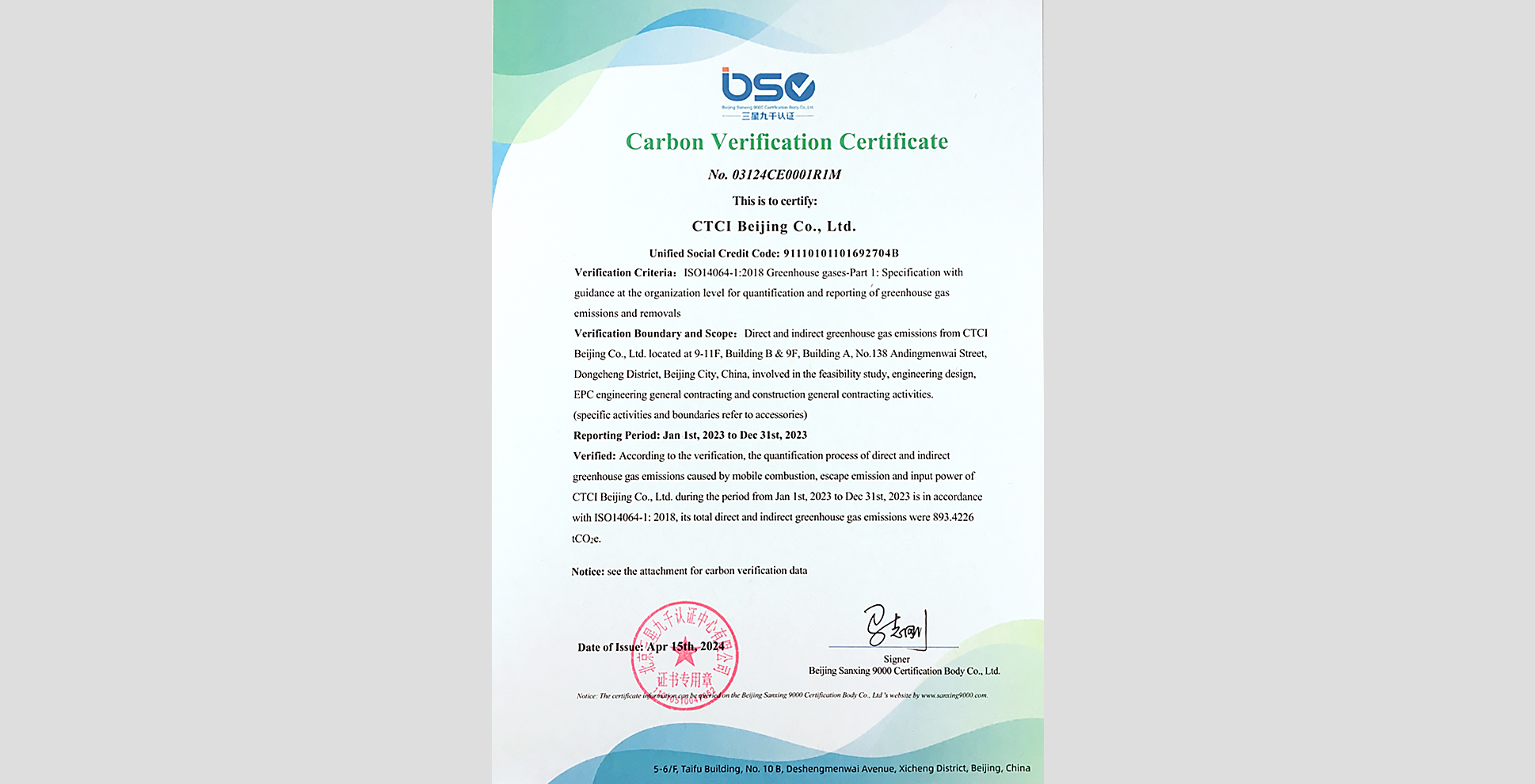Corporate Citizen
企業公民
Putting ESG Concept into Action: CTCI Beijing and CTCI Shanghai Never Shy Away from Corporate Social Responsibility translate into Chinese
CTCI Beijing Company with subsidiary CTCI Shanghai Company, the two affiliates of CTCI Group operating in China for over three decades, have been committed to integrating the ESG concept with their core businesses over the years. Both companies have put the ESG concept into action and aligned themselves to the Group vision for net zero emissions through various means, such as improving the sustainable management structure, encouraging and coaching their employees to take part in the Group’s ESG courses and activities, carrying out "ESG Moments" during meetings, and holding ESG improvement meetings. In this article, we will talk about how CTCI Beijing completed its greenhouse gas verification and promoted sustainable-related actions such as net-zero EPC (Engineering, Procurement and Construction) during project execution.
Completing Greenhouse Gas Verification and Advancing Towards the 2050 Net-Zero Goal
In support of the "dual carbon goals" (a shorthand for "carbon peaking by 2030" and "carbon neutrality by 2060") mandated by the Chinese government that seeks to kickstart a greener transformation across industries, as well as in support of CTCI Group's commitment to achieve "net-zero emissions across all offices by 2030 and across all production sites by 2050," CTCI Beijing and CTCI Shanghai launched a task to take inventory of both companies’ greenhouse gas emissions in 2023. After several months of preparation, a comprehensive review was carried out both in writing and through on-site inspections that encompass company risk analysis, report creation, and in-house technologies. Finally, in early 2024, CTCI Beijing and CTCI Shanghai passed the third-party audit by SanXing 9000 Certification Company and was awarded a Carbon Verification Certificate. Thanks to the inventory-taking, CTCI Beijing and CTCI Shanghai gained more insights on their carbon emissions across offices and project sites. They became more aware of the sources of their carbon emission, the amount of carbon emitted, as well as feasible measures to reduce emissions. Currently, the primary source of CTCI Beijing and CTCI Shanghai’s greenhouse gas emissions is "electricity consumption (94%)," while the primary sources of greenhouse gas emissions at their project sites are "electricity consumption (55%), gasoline consumption for machinery (32%), and methane generated by septic tanks (13%)." In response, CTCI Beijing and CTCI Shanghai have come up with the following measures for implementation in gradual phases to meet carbon reduction targets: • Replace fluorescent light fittings with high-efficiency and energy-saving LED light fittings; replace old electrical appliances with ones that conform to energy efficiency level 1. • Replace company-owned fuel vehicles with electric vehicles or hybrid vehicles; rent pure electric vehicles for construction sites. • Improve power management, purchase green power certificates, or buy green power directly. • Encourage colleagues to take public transport instead of driving. For short distances, walking or biking is encouraged. • Connect septic tanks to municipal pipe networks.

Carbon Verification Certificate
Net-Zero EPC Green Construction Method: Working with Customers for Sustainable Co-Prosperity
In addition to making efforts to reduce carbon emissions in offices and at project sites, CTCI Beijing and CTCI Shanghai also work with customers for sustainable co-prosperity and integrate the ESG concept into the execution process of EPC projects. Design stage: At this stage, much attention is paid to the working environment and labor intensity of subsequent operators. For example, a reasonable design of operation interfaces and working spaces for the automated production line ensures comfort and safe working environment, thus reducing occupational health problems. The impacts on the surrounding communities are also considered. For example, production processes that may generate noises and odors are kept far away from the community. Such facilities are isolated and have noise abatement as well as deodorization measures in place to reduce interference. Procurement stage: CTCI Beijing and CTCI Shanghai are committed to building an environmentally-friendly green supply chain that aligns with the concept of sustainability and saves energy and resources. Both companies strictly screen supply chain manufacturers and require them to follow environmental protection standard. They also manage the material supply from the source to check whether they are environmentally friendly, as well as ensure that the entire product life cycle meets environmental protection requirements. On the other hand, CTCI Beijing and CTCI Shanghai pay attention to the protection of labor rights and suppliers’ interests, making sure that they comply with labor laws and regulations. This includes providing a safe working environment, reasonable working hours and salaries, and avoiding the use of child labor and forced labor. Construction stage: The focus of this stage is to provide a safe and healthy working environment for construction workers, arrange regular occupational health check-ups; strengthen labor safety training to improve workers' awareness of work safety; establish a fair and just labor dispute resolution mechanism to protect the legitimate rights and interests of employees; maintain good communication and interaction with the community; and encourage community residents to monitor the project progress to minimize their resistance during the project construction execution process. In the future, CTCI Beijing and CTCI Shanghai will continue to improve its performance in all aspects of ESG to benefit both the economic development and environmental protection, and looks forward to seize green business opportunities, improve performance, and take big steps towards CTCI Group's 2050 net-zero goal.


.jpg)